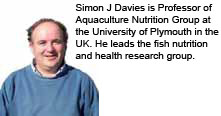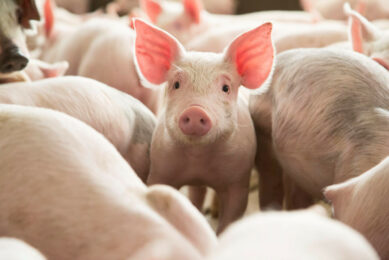Matching mineral requirements in trout

In fish, trace elements play an important role in cellular metabolism, formation of skeletal structures, maintenance of colloidal systems, regulation of acid-base equilibriums and other physiological functions. here we consider trace element bioavailability, particularly the role of organic selenium.
In commercial salmonid diets considerable variation exists in the mineral content of feeds (Figure 1) with the red section indicating the National Research Council (NRC) dietary requirement estimates for small fish (Lall, personal communication). The trace elements copper (Cu), cobalt (Co), iron (Fe), manganese (Mn), molybdenum (Mo) selenium (Se) and zinc (Zn) are associated with specific proteins in metalloenzymes which have unique catalytic functions and they are involved in most aspects of cell biochemistry and function.
In the immune system the role of selenium is particularly important as it is incorporated into the active selenoenzymes as selenocysteine. These have the role of protecting the phagocytic cells of the innate immune system and is one of the best characterised aspects of the essentiality of selenium in disease defence (Arthuret al., 2003). Bioavailability studies have shown that supplementation of fish meal based diets, with Zn and Mn are necessary for optimal growth, bone mineralisation and cataract formation in fish (Lall, 2002). However, our understanding of the effects of trace elements in fish is often limited and incomplete.
Absorbance and excretion
Fish, unlike terrestrial animals, can absorb trace and other inorganic elements from their external aquatic environment in addition to that supplied through their diet. Freshwater fish absorb salts through their gills and this combined with a low body surface permeability enables the fish to maintain blood ion levels at higher concentrations than the external environment. Marine fish loose water through all permeable surfaces and therefore have to replace the lost water osmotically by drinking seawater allowing absorption through the gut into the blood of ions and water.
Fish and crustaceans have been shown to be able to excrete, through the main excretion routes of urine and faeces, excessive trace element intakes and regulate the body concentrations at near normal levels (Buryet al., 2003). The culture of fish species in farm environments such as cages, pond or tanks may take place in fluctuating environmental and water quality conditions.
These factors combining with practical husbandry practises can result in the development of stress situations that can affect the physiology and the trace element requirements at a specific period of time for the species being cultured. These stress conditions can also affect the osmotic and ionic regulation in the gills. In freshwater this can result in passive ion losses and water uptake and in sea water species can increase passive ion influxes and water loss while inhibiting active ion exchanges in both. These effects are brought about by disturbances in plasma ion homeostasis and acid-base balance (Eddy 1981; Evans 1987; Wendelaar Bonga and Lock, 1992).
Excessive amounts
Traditionally, inorganic trace elements Zn, Fe, Cu, Mn and Se are commonly used as supplements in feeds and their discharge in uneaten food and excretion in urine and faeces has been shown to have a direct influence on the aquatic environment.
Recent studies have reported elevated levels of Zn and Cu under sea cages of salmon farms (Smithet al., 2005; Dean et al., 2007). Other studies have shown that Cd, Fe and Mn have been found in sediments and in solid wastes generated by fish farms. The impact of trace mineral discharges from aquaculture on the aquatic environment has been recently reviewed (Lall and Milley, 2008). This work highlights some environmental concerns and necessitates a more precise understanding of dietary requirement, uptake mechanisms, the interaction and bioavailability of trace elements from both feed ingredients and supplemented minerals (inorganic or organic) in the diet. Generally the trace element concentrations in soft tissues of fish such as muscle, liver and bone are used as indicators of nutritional status levels of practical diets (Dove and Kingsford, 1998). Recent studies not only measure tissue retention, but are focusing on the utilisation of these elemental tissue reserves in developmental stages, times of stress and health challenges in order to maintain optimal performance and health status. This knowledge base will help to better understand the physiological and biochemical processes involved and avoid excessive amounts of unutilised trace elements being released to the environment, which in turn will minimise adverse environmental effects.
Studies in rainbow trout
In rainbow trout, recent studies undertaken by Sebastien Rider under the supervision of Professor Simon Davies at the University of Plymouth have investigated some of these issues with respect to selenium nutrition.
The effect of both organic and inorganic sources of selenium was investigated under stress situations and interaction with other trace elements in practical diets was considered. In this work a selenoyeast, Sel-Plex®,Saccharomyces cerevisiaeCNCMI-3060 (Alltech Inc.) –hereafter called organic selenium – was compared to inorganic sodium selenite as a supplement in practical rainbow trout diets.
The Se status of the majority of tissues responded positively to Se supplementation. For most tissues the greatest increase in tissue Se was achieved with Sel-Plex supplementation. Muscle tissue, an important location of essential selenium reserves showed significantly increased levels of Se as a result of organic selenium supplementation when compared to the inorganic form (Figure 2). This is in agreement with previous studies, which show that organic but not inorganic Se, is deposited in these tissues due to the non-specific incorporation of SeMet. Whole body Se status was only significantly greater in the organic selenium supplemented diet with no difference between the non-supplemented control and the selenite supplemented group.
Whole body accumulation
In a further study, the whole body selenium accumulation was investigated at various supra nutritional levels of either organic selenium or sodium selenite for 10 weeks of feeding followed by the application of husbandry related stressors. Whole body Se accumulation from selenite followed an exponential dose response pre-stress and a linear dose response post-stress (Figure 3). The level of whole body selenium accumulation was lower than that observed with the organic form. The whole body Se accumulation from organic selenium followed a linear dose response pre-stress and post-stress. The Se loss due to stress is highlighted by the red arrows and shows that the greatest loss of Se was observed in the selenite fed fish at 8 mg kg-1. The different pattern of Se loss at higher Se levels by stress indicates a different metabolic process between organic selenium and selenite with organic selenium maintaining higher reserves and less utilisation in stress situations. Inorganic Se accumulates in the liver at high levels of dietary Se, possibly due to a limit in methylation required for its excretion and appears to be rapidly mobilised during stress to the detriment of the organism. However, being non-specifically incorporated organic Se is released slowly maintaining Se to the required levels throughout periods of stress.
Stress levels
In the same study handling and confinement stress had no significant effect on the whole body levels of Cu Fe, Mn or Zn in rainbow trout. However when selenium was added in the diet as inorganic selenite, both pre and post stress, a strong interaction was observed between dietary selenite and whole body copper. However no such interaction between these two nutrients was observed when selenium was added as organic selenium. This demonstrates that having a different route of uptake and incorporation in biological compounds, organic Se is less prone to the effects of anti-nutritional factors such as Cu and other interactive effects post absorption. The supplementation of a single nutrient may often through interactions be to the detriment of another (Sandstrom, 2001). Interestingly this study also showed that unlike Se, whole body Fe, Mn, Zn and Cu are not decreased by handling stress and therefore reserves of these minerals may be maintained during physical stress. However, due to the compartmentalisation of trace elements, levels of these minerals post stress in individual tissues such as plasma Zn need to be assessed.
The incorporation of Se into metabolically active selenoproteins was investigated using the Se enzyme activity/tissue Se ratios. The thioredoxin reductase/liver Se ratio increased to a greater extent with organic selenium rather than selenite supplementation. Although both types of Se supplementation resulted in similar hepatic Se levels, the organic Se was found to be more efficiently incorporated into the Se proteins. In this study with a basal diet containing 1.2mg/kg of selenium and with the addition of 0.6 mg/kg organic selenium or inorganic selenium the glutathione peroxidise (GPX)/liver Se ratios were not affected. However in a second study using supra nutritional levels of selenium of up to 8mg/kg following husbandry stress a clear correlation between increasing organic Se and increasing GPX activity was observed. The opposite was seen with selenite.
Conclusions
Further investigations to improve our understanding of trace element form and function, particularly their effect on dietary requirement, the physiological and biochemical processes will allow optimal nutrition of these micronutrients and minimise adverse environmental effects. These studies in rainbow trout have shown that the bioavailability of Se is superior in the organic source and in this digestible form it is more effectively, non-specifically accumulated in essential tissues than the inorganic form. Organic selenium is not lost as rapidly during periods of stress and does not negatively interact with other trace elements. In practical farming conditions physical stress may result in elevated Se utilisation and consequently the supplementation of commercial diets may be necessary to ensure that Se reserves are available as a contingency for stress.











